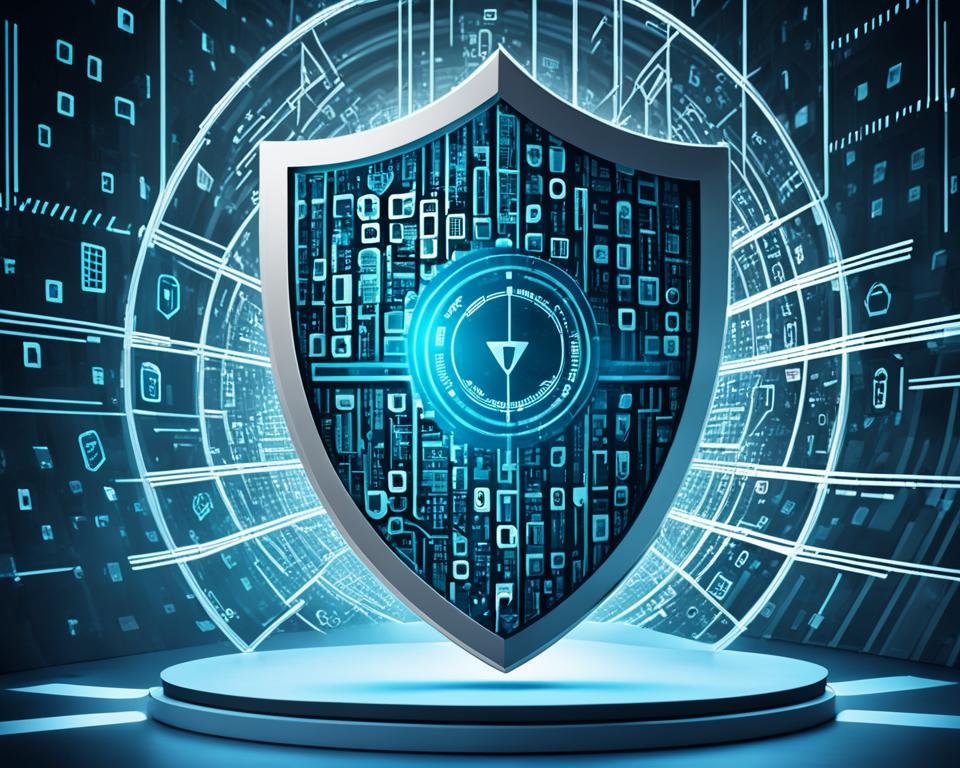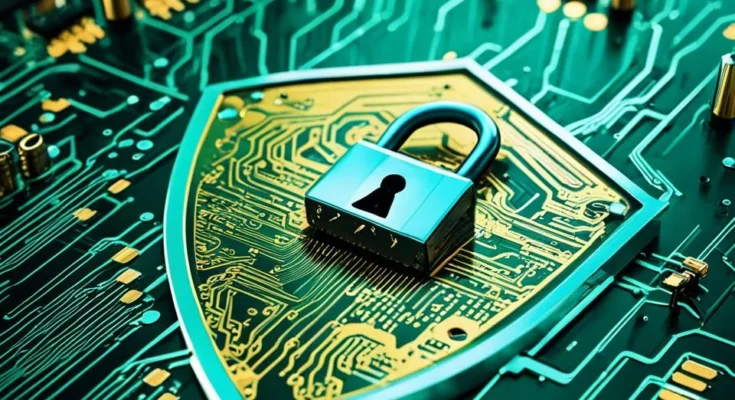
Key Takeaways
- Understand the importance of robust cybersecurity and data privacy measures in the modern digital era
- Discover high-end solutions to protect your organization’s critical assets and sensitive information
- Learn about the latest technologies and best practices for network security, data protection, and compliance
- Explore strategies to mitigate cyber threats and vulnerabilities, ensuring the resilience of your digital infrastructure
- Gain insights into incident response and disaster recovery planning to maintain business continuity in the face of cyber attacks
The Importance of Cybersecurity and Data Privacy in Today’s Digital Landscape
In today’s digital world, data is very valuable for both businesses and people. But, it’s also a big target for cyber threats. It’s important to know about the risks and effects of these threats, like data breaches and identity theft.
Understanding the Risks and Consequences of Cyber Threats
Cybercriminals keep coming up with new ways to get to sensitive info. Data protection and privacy compliance are key. A cyber attack can cause big financial losses and harm a company’s reputation.
The Evolving Landscape of Cybersecurity Challenges
Technology keeps getting better, and so do hackers’ methods. It’s important for people and companies to keep up with cybersecurity. They need to update their risk assessment plans often to stay safe.
“The cybersecurity landscape is constantly shifting, and it’s essential for organizations to stay ahead of the curve to protect their data and safeguard their operations.”
Having strong cybersecurity and data privacy is very important today. By understanding the risks and keeping up with new info, businesses and people can protect their digital stuff. This helps keep their customers and stakeholders trusting them.
Comprehensive Network Security Solutions
In today’s world, keeping your digital assets safe needs a strong network security plan. At the heart of this plan are advanced firewalls and intrusion detection systems. They work hard to keep your network safe from unauthorized access and suspicious activities.
Firewalls and Intrusion Detection Systems
Firewalls guard your network’s entry points, blocking harmful traffic. With the latest firewall tech, you can make sure only approved users and apps get in. IDS systems then check network traffic for odd patterns or threats.
These tools together create a strong defense against cyber threats. By using top-notch firewalls and IDS, you can safely move through the digital world.
Virtual Private Networks and Secure Remote Access
With more people working from home, keeping your network safe is key. Virtual private networks (VPNs) help by encrypting data in transit. This lets remote workers safely and privately access your resources.
Adding strong remote access controls, like multi-factor authentication, keeps your network secure. This way, only the right people can get into your network. It lets your company work remotely safely and keep data protected.
“Cybersecurity is not just an IT issue, it’s a business imperative. Investing in comprehensive network securitysolutions is a critical step in safeguarding your organization’s digital future.”
Cybersecurity and Data Privacy
In today’s digital world, cybersecurity and data privacy go hand in hand. They protect sensitive info and digital assets from unauthorized access and misuse. By using strong cybersecurity steps, companies keep their data safe and respect the privacy of everyone involved.
Cybersecurity keeps systems and data safe from cyber threats like hacking and malware. Data privacy makes sure personal info is handled right, following the law and ethical standards.
When cybersecurity and data privacy work together, companies get better protection and trust. This lowers the risk of data breaches and damage to their reputation. It shows they care about keeping info safe and doing things right.
To keep things safe, companies need a strong plan for cybersecurity and data privacy. This means using different solutions and strategies based on their needs and industry. Some key steps include:
- Strong access controls and ways to prove who you are
- Good data encryption and secure storage
- Regular checks for weak spots and tests to see how secure you are
- Plans for handling incidents and getting back on track
- Training and awareness programs for employees
By focusing on cybersecurity and data privacy, companies protect their digital stuff and gain trust. This helps them succeed in the changing digital world.
Encryption Technologies for Data Protection
In today’s digital world, encryption is key to keeping sensitive info safe. It helps protect digital assets from unauthorized access and misuse. By using advanced encryption, both businesses and individuals can keep their data secure.
Encryption changes readable data into a secret code, called ciphertext, with complex math. This way, even if data is stolen, it can’t be read by others. This is crucial with new privacy laws that require strong encryption for data protection.
AES (Advanced Encryption Standard) is a top encryption type. It’s approved by the U.S. National Institute of Standards and Technology (NIST). AES is very secure and used a lot in healthcare, finance, and government.
Other encryption types include:
- RSA (Rivest-Shamir-Adleman) encryption, a public-key system for secure data and digital signatures.
- Elliptic Curve Cryptography (ECC), a public-key system that’s more efficient and secure than RSA.
- Blockchain-based encryption, which uses blockchain’s secure, unchangeable nature to protect data.
Using these encryption technologies helps keep your data safe and follow privacy laws. This makes your data protection stronger and builds trust with your customers and stakeholders. It shows your organization is a leader in data security and privacy.
| Encryption Technology | Key Features | Suitable Applications |
|---|---|---|
| AES (Advanced Encryption Standard) |
|
|
| RSA Encryption |
|
|
| Elliptic Curve Cryptography (ECC) |
|
|
| Blockchain-based Encryption |
|
|
By using these encryption technologies, you can protect your data and follow privacy laws. This makes your data protection stronger and builds trust with your customers and stakeholders.
Vulnerability Management and Penetration Testing
In today’s fast-changing cybersecurity world, it’s key to manage vulnerabilities and test for weaknesses. Doing so helps protect your digital assets. By finding and fixing weaknesses in your systems and networks, you lower the chance of cyber attacks.
Identifying and Mitigating Vulnerabilities
Vulnerability management is ongoing. It means scanning your setup for weak spots. This includes finding software bugs, misconfigurations, and other security holes that hackers could use. After spotting these issues, it’s important to fix them quickly. Use patches, updates, or other fixes to keep your systems safe.
The Role of Ethical Hacking in Cybersecurity
Ethical hacking is a big part of cybersecurity too. Ethical hackers, or “white hat” hackers, act like real hackers but for good. They try to find and fix weaknesses before bad guys can. By mimicking real attacks, they help you find hidden issues and plan how to respond to them.
Using a proactive approach to managing vulnerabilities and ethical hacking boosts your cybersecurity. It helps protect your digital assets from new threats.
“Vulnerability management is not a one-time task, but a continuous process that requires vigilance and a proactive mindset.”
Identity and Access Management Solutions
In today’s digital world, keeping sensitive info safe and making sure only the right people get in is key. Identity and access management (IAM) solutions are vital for better cybersecurity and data privacy. They help check who users are and control their access to important stuff. This lowers the chance of unauthorized access and data breaches.
Multi-Factor Authentication and Biometric Security
Multi-factor authentication (MFA) is a big part of IAM solutions. It makes things more secure by asking for more than one form of ID, like a password, a code on your phone, or a biometric like your fingerprint. This makes it harder for hackers to get in, as they’d have to get past several checks.
Biometric security, like using your fingerprint or face, takes it up a notch. It uses your unique body traits to check who you are. This makes it really tough for bad guys to pretend to be someone else. Adding biometric security to IAM plans makes digital assets safer and keeps data safe from unauthorized access.
| Feature | Password | Multi-Factor Authentication | Biometric Security |
|---|---|---|---|
| Security Level | Low | Medium | High |
| Ease of Use | High | Medium | High |
| Reliability | Low | Medium | High |
Using a full IAM solution with MFA and biometric security makes a big difference in cybersecurity. It helps protect digital assets and keeps data safe. This is key to fighting off new threats in the digital world.
Risk Assessment and Compliance
In today’s digital world, keeping your data safe and private is crucial for all kinds of organizations. Doing thorough risk assessments and following standards and regulations is key to protecting your digital stuff.
Risk assessment means looking for and understanding threats and weaknesses in your IT setup. By tackling these risks early, you can make a plan to lessen the harm from cyber attacks and keep your important data safe.
Aligning with Industry Standards and Regulations
Following standards and privacy laws is vital for good risk management. Laws like the GDPR and HIPAA set strict rules for protecting data and privacy. Meeting these standards not only keeps your digital stuff safe but also prevents big fines and damage to your reputation.
To follow standards and regulations, take these steps:
- Do a deep check of your current cybersecurity and data privacy steps to see where you’re not meeting the rules.
- Make and use strong policies and steps that follow the laws.
- Train your employees well on how to handle data privacy and follow the rules.
- Keep updating your cybersecurity steps to keep up with new threats and law changes.
| Industry Standard | Key Requirements |
|---|---|
| GDPR | Strict data protection, consent management, breach notification |
| HIPAA | Safeguarding of protected health information, access controls, incident response |
| PCI DSS | Secure handling of payment card data, network security, vulnerability management |
By tackling risk assessment and following standards and regulations, you show you care about cybersecurity and data privacy. This builds trust with your customers and others.
“Compliance is not just about avoiding fines and penalties – it’s about safeguarding your organization’s most valuable assets and maintaining the trust of your customers.”
Incident Response and Disaster Recovery
In today’s digital world, even the best cybersecurity can face tough cyber threats. It’s key to have a solid incident response plan and a strong disaster recovery strategy. These plans help lessen the blow of security issues and keep your business running smoothly.
Starting with threat detection technologies is key to a good incident response. These tools help spot and tackle security breaches fast. By always watching your systems and networks, you can catch oddities early, stop the damage, and start fixing things right away.
- Make a clear, practiced incident response plan that shows who does what and how to talk to each other.
- Test your response steps often to make sure your team is ready for different security problems, like data theft or malware.
- Have strong backup and recovery plans to protect your important data and systems if disaster strikes, whether it’s natural or man-made.
Having a disaster recovery plan is a must for good cybersecurity. With a solid plan, you can get your systems and data back fast after a big problem. This cuts down on lost time and money, and helps keep your reputation safe.
| Incident Response | Disaster Recovery |
|---|---|
| Focuses on quickly responding to security issues to stop more damage and lessen the impact. | Works on getting systems, data, and operations back after a big disruption or disaster. |
| Focuses on fast threat detection, analysis, and fixing. | Works on getting key business functions back fast and protecting important data. |
| Helps the organization get back to normal quickly and limits more damage. | Helps an organization bounce back from disasters like natural events, cyber attacks, or system failures. |
By combining incident response and disaster recovery in your cybersecurity plan, you protect your digital assets better. This keeps your business going and shows you care about handling data responsibly.
“Preparedness is the key to weathering any storm, whether it’s a natural disaster or a cyber attack. By having a well-tested incident response plan and a robust disaster recovery strategy, you can ensure the resilience of your organization in the face of the unexpected.”
Conclusion
In today’s digital world, keeping your organization safe is key. Working with a trusted expert helps you use top-notch solutions. These protect your important digital stuff from threats online.
By using the latest cybersecurity tech and following best practices, you can handle the digital world’s challenges. You’ll get strong network security, top encryption, and identity management tools. The right partner will help your organization stay ahead of threats.
As you move forward in the digital world, remember to focus on cybersecurity and data privacy. Choosing the right solutions and following industry rules keeps your digital assets safe. This way, your operations will run smoothly, and your reputation stays strong, even against tough cyber threats.



